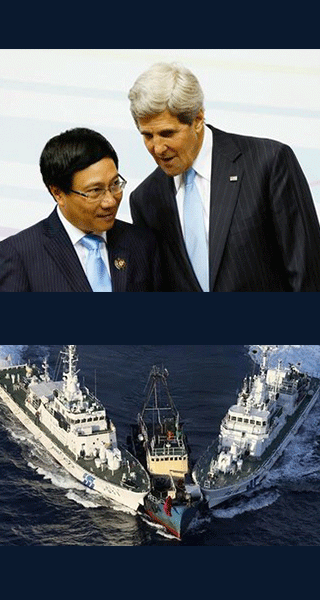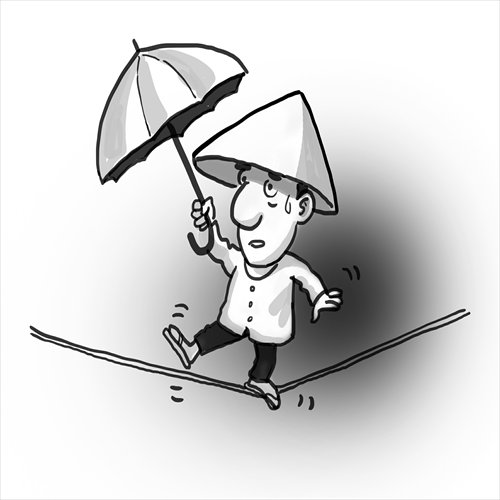YaleGlobal: Vietnamese Foreign Minister Pham Binh Minh and US Secretary of State John Kerry will meet in Washington early October. The two nations, at war more than 40 years ago, now find common interest in protecting open sea lanes in the South China Sea. China asserts sweeping claims, going as far as to construct new islets and impose limitations on the use of other nations’ exclusive economic zones. China signed the UN Convention on the Law of the Sea, the United States has not. “Kerry and Minh should work out a middle course that protects US policy autonomy while maintaining balance in the region,” writes former US diplomat David Brown. Diplomacy and increased US engagement could include training regional coast guards with the aim of minimizing risky maneuvers that could trigger greater conflict, lifting a ban on weapons sales to Vietnam, encouraging joint explorations for oil and gas and encouraging multilateral fisheries management. In the meantime, Brown urges Brunei, Malaysia, Vietnam and the Philippines to waste no time in sorting out their own competing claims.
Blocking China’s salami-slicing tactics on the South China Sea require region-wide cooperation
David Brown / YaleGlobal, 25 September 2014
 |
| Battle over waters: US Secretary of State John Kerry and Vietnam's Foreign Minister Pham Binh Minh will meet in early October to discuss the South China Sea (top); earlier in the summer China's coast-guard ships rammed a Vietnamese vessel near a Chinese oil drilling rig |
FRESNO: When Vietnamese Foreign Minister Pham Binh Minh and US Secretary of State John Kerry meet in early October, China's aggressive behavior in the waters of Southeast Asia will top their agenda. In the months leading up to the meeting, Washington’s foreign policy elite have been debating whether it is in America’s interest to get involved in the dispute. The strategic implications of letting China have its sway are too serious for the US to adopt a binary policy of going in all guns blazing or looking the other way. Kerry and Minh should work out a middle course that protects US policy autonomy while maintaining balance in the region.
China is a rising power and its cooperation is essential in efforts to contain terrorism, slow climate change, curb nuclear proliferation and so on. But the US cannot ignore China's drive to establish hegemony over the seas that touch its shores. Cautiously in the East China Sea, where Japan, allied with the United States, is a formidable opponent, and confidently in the South China Sea, China has mounted a determined challenge to the international order expressed in the UN Convention on the Law of the Sea, UNCLOS, and the notion that territorial disputes should be settled, not by force, but by negotiation or arbitration.
Six years ago China presented a crude map to illustrate its claim to "indisputable sovereignty" over the area bounded by a nine-dash line enclosing 3.5 million square kilometers.
With each year that's passed since then, China's upped the ante. Deploying hundreds of deep-sea fishing boats and many dozens of coast guard vessels, Beijing has challenged its neighbors' sovereignty over exclusive economic zones drawn according to UNCLOS rules. It has driven Vietnamese fishermen out of traditional fishing grounds, wrested the aquatic resources of Scarborough Shoal from Manila's control, harassed oil and gas exploration off Vietnam's central coast, and planted markers on James Shoal, 50 miles off the Malaysian coast and 2200 miles south of China's Hainan Island. This year China again proved its mastery of the tactical initiative, deploying a deep-sea oil drilling rig and an armada of escort vessels into waters near Vietnam's central coast while sending a flotilla of seagoing pumps, dredges and cement mixers further south with the mission of converting a handful of reefs into artificial islets.
The US cannot ignore China's drive to establish hegemony over the seas that touch its shores.
|
Beijing has been impervious to persuasion and angered by tough talk from US diplomats – from Hillary Clinton and Kerry on down. Xi Jinping's government may know that the records it relies on to support an "historic claim" to the South China Sea are legally untenable, but Chinese public opinion finds them persuasive. China's man in the street is furious that countries on the periphery of "China's South Sea" are "stealing China's resources" when they fish on the high seas or drill for offshore oil and gas.
China, it seems, has no intention of submitting its sweeping territorial claims to rulings by international tribunals. It evidences little more interest in negotiating a Code of Conduct with the Association of Southeast Asian Nations. At most, Chinese spokesmen have hinted at a disposition to be generous when and only when Vietnam or the Philippines acknowledge the superior merit of China's claims.
It has thus become impossible to regard the South China Sea as an inconsequential sideshow to a hoped-for entente between the United States and the emergent Chinese superpower. The conflict is not inconsequential – the sea lanes carry nearly half the world's commerce. Added now is profound worry that Beijing's steadily more aggressive tactics there and its dismissal, whenever inconvenient, of the rules of the international order reveal China’s true nature with which the international community must contend in other places in times to come. China's actions and attitudes have made confrontation in the South China Sea a central concern of US diplomacy and strategic planning.
China shows no intention of submitting sweeping claims to rulings by international tribunals.
|
In the South China Sea, as elsewhere in the world, US engagement is essential if China's ambitions are to be effectively countered. Tough talk alone will not stiffen the ASEAN backbone nor impress Beijing.
From a tactical perspective, the US has behaved as if there were no viable options in the large space between denunciation of Chinese provocations and deploying the 7th Fleet. China on the other hand has consistently exploited opportunities in the middle space. It has relied on paramilitary assets, coast guard ships and auxiliary "fishing boats," to further its sovereign ambitions while the Peoples Liberation Army Navy, PLAN, waits discreetly just over the horizon.
Mimicking Chinese tactics, the US and Asian friends and allies could step up cooperation among their coast guards, prominently including a robust schedule of multilateral training exercises at sea. Military assistance that enhances Southeast Asian states' abilities to keep watch over their maritime frontiers will reduce China's capability to spring unpleasant surprises. Skillfully managed, such activities would, Carlyle Thayer has argued, "put the onus on China to decide the risk of confronting mixed formations of vessels and aircraft."
Washington ought also to forge a much closer relationship with Vietnam, the only Southeast Asian country with both the military deterrent capacity and, assured of American backing, the will to stand up to China. China's drill-rig deployment in May stunned Hanoi's Communist leaders and may have tipped the Politburo balance against continued strenuous efforts to appease Beijing.
A higher profile of American engagement vis-à-vis China in the South China Sea ought to reinforce diplomacy.
|
Hanoi and Washington have been courting since summer of 2012 and that intensified this summer. Largely for reasons of face – Vietnam doesn't like being lumped in with North Korea, Iran, Syria and China – it wants the US to drop its ban on lethal weapons sales. Washington, meanwhile, has conditioned such sales on "movement" on human-rights issues – an issue also likely to figure in Kerry-Minh talk.
Forging a strategic entente is not easy for either Hanoi or Washington. Each must give a bit on political rights. Yet, with the wolf at Hanoi's door, pragmatic adjustments may lay the foundation of an effective counter to Beijing's drive for hegemony over the South China Sea and domination of adjacent nations.
The US has already intervened effectively in support of the Philippines. Steps to upgrade and reinforce Philippine maritime surveillance and self-defense capabilities have had a tonic effect, allaying concerns that Manila may engage in risky, desperate behavior.
A higher profile of American engagement vis-à-vis China in the South China Sea ought to reinforce diplomacy. In that respect, the US could press Brunei, Malaysia, Vietnam and the Philippines to sort out their claims among themselves. It could foster initiatives to draw Chinese authorities into discussions of multilateral management of rapidly depleting ocean fisheries and Chinese firms into joint exploration of the seabed for oil and gas.
There's no way for the United States to engage more actively in the South China Sea issues without angering China. That would probably have short-term negative consequences for US-China cooperation in other arenas, though Beijing is unlikely to refrain from cooperation that is in its own interest in order to punish Washington. The longer-term consequences of limiting China's overweening ambition will be salutary – Beijing will understand that it cannot rewrite the rules of international relations at will.
David Brown is a retired American diplomat who writes on contemporary Vietnam. He may be reached at nworbd@gmail.com.





